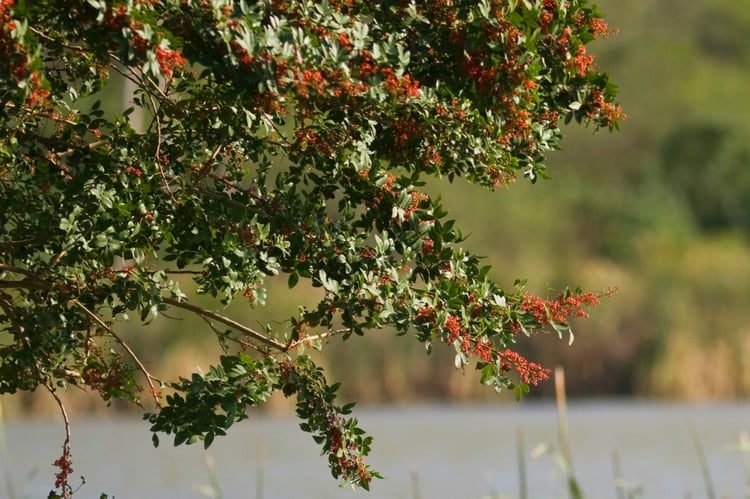The Invasive Brazilian Peppertree
Dec 03, 2020 . 3 min read


The Brazilian peppertree (Schinus terebinthifolius) grows natively in Argentina, Paraguay, and Brazil, and Americans first brought it to Florida in the 1840s. Today, this invasive species occurs in some of the United States' warmest regions, including Florida, California, Hawaii, Texas, and Georgia.
As an invasive species in the U.S., the Brazilian peppertree overtakes the areas where it grows and displaces native plants due to its harmful properties. Florida and Texas classify the Brazilian peppertree as a noxious weed.
If you need to address a Brazilian peppertree invasion on your property, you have a few removal options.
Identifying the Brazilian Peppertree
Despite its name, the Brazilian peppertree can appear as a medium-sized tree or a shrub reaching 15 to 30 feet in height. It has informal names like "Florida holly" and "Christmas berry" because of its evergreen growth and bright red berries. Brazilian peppertrees have the following distinctive traits:
- Bark: It has gray bark with either a smooth texture or a surface that furrows into narrow, flat ridges.
- Foliage: The 1 to 2-inch long evergreen leaves feature a dark green color and appear in clusters of three to 11 leaves. When crushed, they have a peppery or turpentine-like smell, but be careful — the sap can irritate the skin and lungs. The leaves alternate sides on each stem, leading to an asymmetrical appearance in a growth pattern called alternate pinnate.
- Flowers: When in bloom, the flowers have five white petals that measure up to 2 millimeters long.
- Fruit: The flowers make way for berry clusters that ripen from a glossy green to a bright red. This fruit appears directly after the two main blooming periods — one major period in late fall and winter and a minor one in the spring.
Photo Credit: https://janedata.wordpress.com/2008/09/27/brazilian-pepper-tree-seedling-removal/
Damage Caused by the Brazilian Peppertree
Brazilian peppertrees damage their surrounding environment by forming dense thickets that take over the nearby ecosystem. They thrive on cleared land such as ditches, power line right-of-ways, and unused farmland. These invasive plants create a hostile environment for other plants and animals to live in due to their:
- Rapid, dense growth: Brazilian peppertrees quickly grow in dense thickets that eliminate other plants through a lack of space and sufficient light. They have high environmental tolerance levels, growth rates, and seed production that quickly overtake other greenery.
- Dispersion: Thanks to its hardiness and berry yield, the Brazilian peppertree spreads easily between areas. It has a higher tolerance to drought, shade, and fire than many native plants, allowing it to invade extreme environments. The female Brazilian peppertree has an incredibly high berry yield that non-native, fruit-eating birds disperse when they eat.
- Irritating bark, leaves, and fruit: This shrub-to-tree has genetic relation to poison oak and poison ivy, making its resin irritating to the touch. In some cases, the resin can become toxic to humans and animals, impacting the surrounding ecosystem.
- Allelopathic substances: Brazilian peppertrees contain allelopathic chemicals — substances that suppress the growth of other plants. Research suggests that they can release these chemicals through their leaves, seeds, or bark.
- Poor suitability for wildlife habitat: The aggressive nature of the Brazilian peppertree leads to the displacement of native plants and the wildlife that rely on them as a food source. Many of the above factors eliminate native greenery, leaving nothing for local wildlife to use as food or shelter.
How to Get Rid of the Invasive Brazilian Peppertree
The primary removal methods for the Brazilian peppertree include:
- Controlled burns: When performed on a strict schedule and with care, controlled burns can prevent Brazilian peppertree growth. While Brazilian peppertree seeds won't survive fire, a sapling will grow more aggressively after fire exposure. Research shows that controlled burns at five-year intervals can keep this invasive tree from growing because of these factors. To ensure safety, the burning process should account for the tree's smoke and sap's irritating properties.
- Biological controls: By releasing certain species of insects into habitats with the Brazilian peppertree, environmental agencies can reduce the tree's population. Organizations in Florida collaborated on one of these initiatives in 2019.
- Chemical removal: A wide range of herbicides work on the Brazilian peppertree, including growth regulators, aromatic amino acid inhibitors, branched-chain amino acid inhibitors, and photosynthetic inhibitors. The first three categories of herbicide work most effectively in late summer or autumn during active growth. Photosynthetic inhibitors have the best results during pre-emergence at the start of the rainy season.
- Mechanical removal: Mechanical removal with equipment such as a skid-steer attachment can prevent
re-sprouting when performed correctly. During this process, the skid-steer user needs to remove the entire root system without disturbing any peppertree seed on the plant. As a result, mechanical removal works best on smaller trees in controlled areas like private property, in non-blooming seasons, to prevent the dispersal of seeds.
Explore Land Clearing Attachments from Diamond Mowers

With a skid-steer attachment from Diamond Mowers, you can cut, mulch, and grind Brazilian peppertrees to remove them from your property. We recommend two attachments for this tree:
- Skid-Steer Forestry Disc Mulcher: For cutting trees and shrubs up to 14 inches in diameter and mulching trees and shrubs up to 6 inches in diameter
- Skid-Steer Drum Mulcher: For mulching trees and shrubs up to 9 inches in diameter
If you have a question about our products, contact our team or find a Diamond Mowers dealer near you. Our team of specialists will help you find the right product for your specific land clearing, trimming, and mulching needs.




